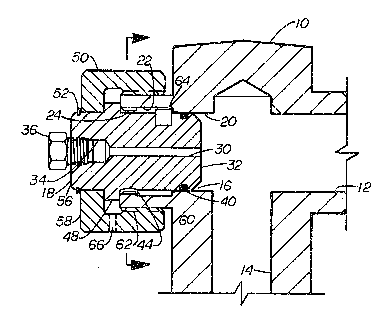Some of the information on this Web page has been provided by external sources. The Government of Canada is not responsible for the accuracy, reliability or currency of the information supplied by external sources. Users wishing to rely upon this information should consult directly with the source of the information. Content provided by external sources is not subject to official languages, privacy and accessibility requirements.
Any discrepancies in the text and image of the Claims and Abstract are due to differing posting times. Text of the Claims and Abstract are posted:
| (12) Patent Application: | (11) CA 2007158 |
|---|---|
| (54) English Title: | SAFETY CONNECTION INTO PASSAGES IN A TUBULAR BODY |
| (54) French Title: | RACCORDS DE SECURITE POUR PASSAGES DANS UN CORPS TUBULAIRE |
| Status: | Deemed Abandoned and Beyond the Period of Reinstatement - Pending Response to Notice of Disregarded Communication |
| (51) International Patent Classification (IPC): |
|
|---|---|
| (72) Inventors : |
|
| (73) Owners : |
|
| (71) Applicants : |
|
| (74) Agent: | SMART & BIGGAR LP |
| (74) Associate agent: | |
| (45) Issued: | |
| (22) Filed Date: | 1990-01-04 |
| (41) Open to Public Inspection: | 1990-07-25 |
| Availability of licence: | N/A |
| Dedicated to the Public: | N/A |
| (25) Language of filing: | English |
| Patent Cooperation Treaty (PCT): | No |
|---|
| (30) Application Priority Data: | ||||||
|---|---|---|---|---|---|---|
|
Abstract of the Disclosure
A safety connection for connecting a plug into a
tubular member, the tubular member having an internal
sealing surface, an internal recess positioned outward from
said internal sealing surface, said recess ending in
inwardly extending lip with a plurality of slots
therethrough and external threads; a plug having a body
with a plurality of radially extending pins positioned to
pass through said slots in said lip, a radially extending
flange and a pin extending radially outward from the plug
at a position immediately axially inward of said flange and
being out of axial alignment with said pins and sized to
fit within one of said slots to position said plurality of
pins out of alignments with said slots; and a securing ring
having an inwardly extend flange for surrounding the
exterior of said plug on the exterior side of said plug
flange and internal threads for engaging the external
threads on said tubular member to secure said plug in said
tubular.
Note: Claims are shown in the official language in which they were submitted.
Note: Descriptions are shown in the official language in which they were submitted.

2024-08-01:As part of the Next Generation Patents (NGP) transition, the Canadian Patents Database (CPD) now contains a more detailed Event History, which replicates the Event Log of our new back-office solution.
Please note that "Inactive:" events refers to events no longer in use in our new back-office solution.
For a clearer understanding of the status of the application/patent presented on this page, the site Disclaimer , as well as the definitions for Patent , Event History , Maintenance Fee and Payment History should be consulted.
| Description | Date |
|---|---|
| Inactive: IPC from MCD | 2006-03-11 |
| Inactive: Abandon-RFE+Late fee unpaid-Correspondence sent | 1997-01-06 |
| Inactive: Adhoc Request Documented | 1997-01-06 |
| Application Not Reinstated by Deadline | 1996-07-06 |
| Time Limit for Reversal Expired | 1996-07-06 |
| Inactive: Adhoc Request Documented | 1996-01-04 |
| Deemed Abandoned - Failure to Respond to Maintenance Fee Notice | 1996-01-04 |
| Application Published (Open to Public Inspection) | 1990-07-25 |
| Abandonment Date | Reason | Reinstatement Date |
|---|---|---|
| 1996-01-04 |
Note: Records showing the ownership history in alphabetical order.
| Current Owners on Record |
|---|
| COOPER CAMERON CORPORATION |
| Past Owners on Record |
|---|
| KENNARD W. TAYLOR |